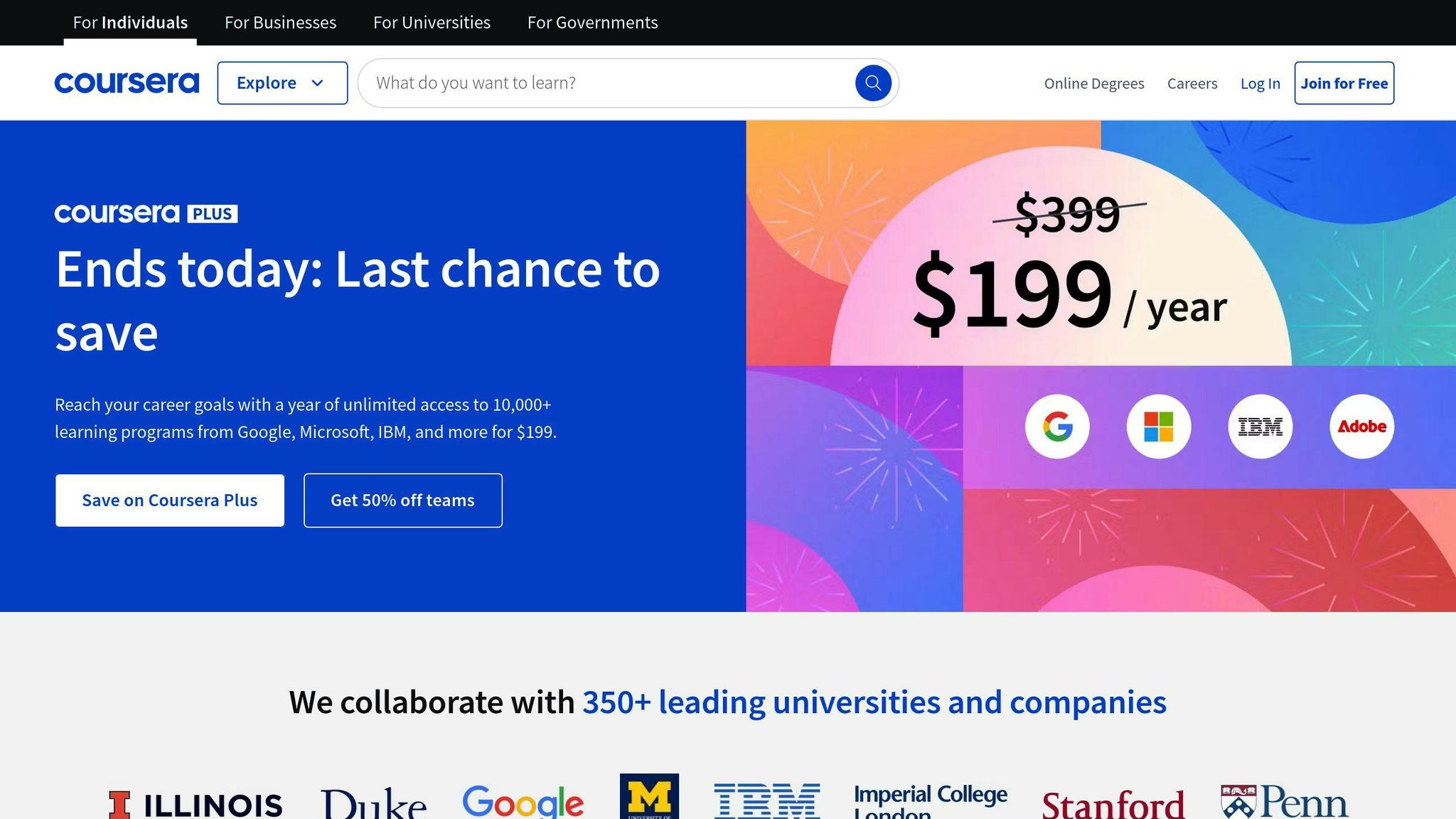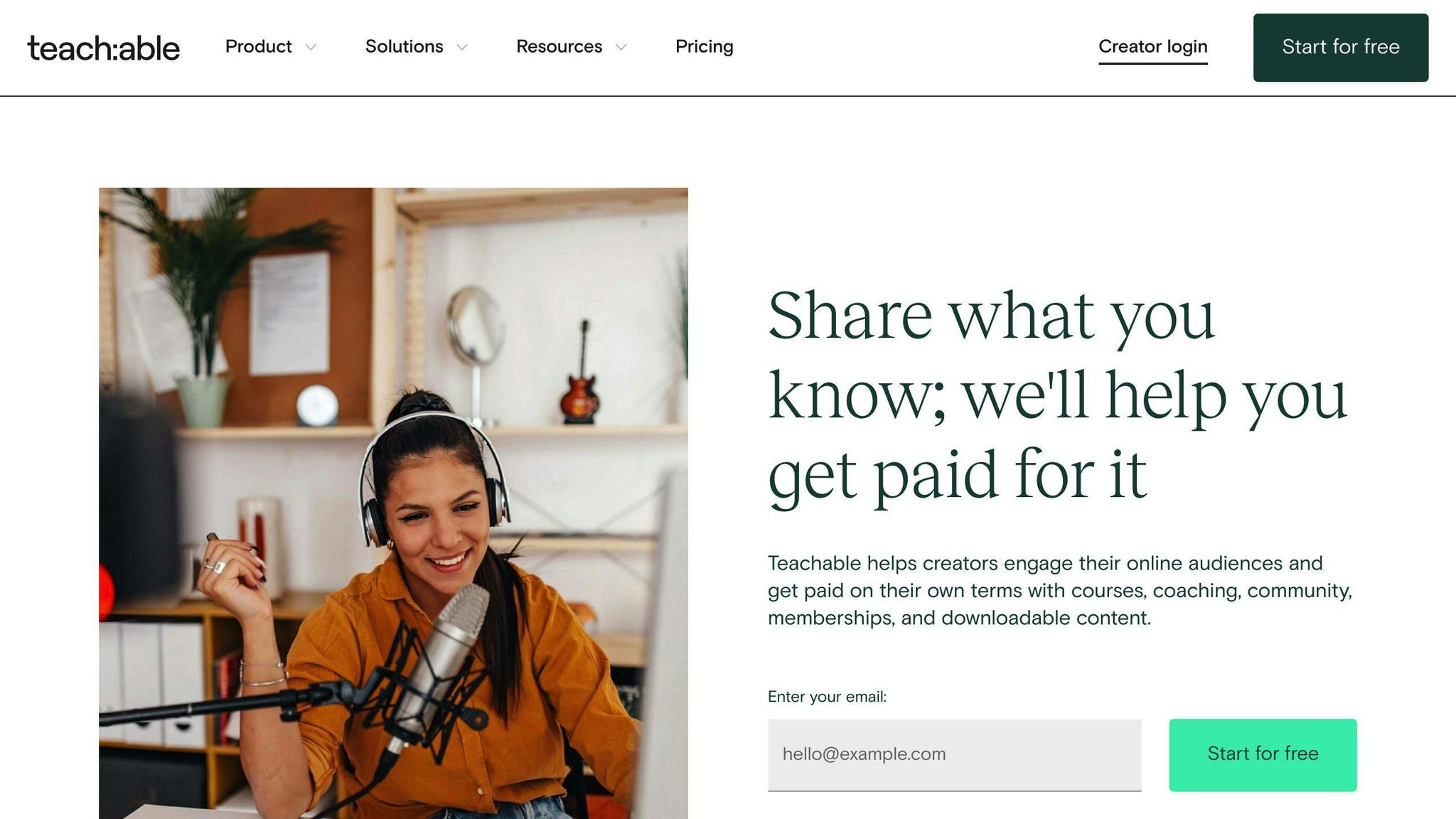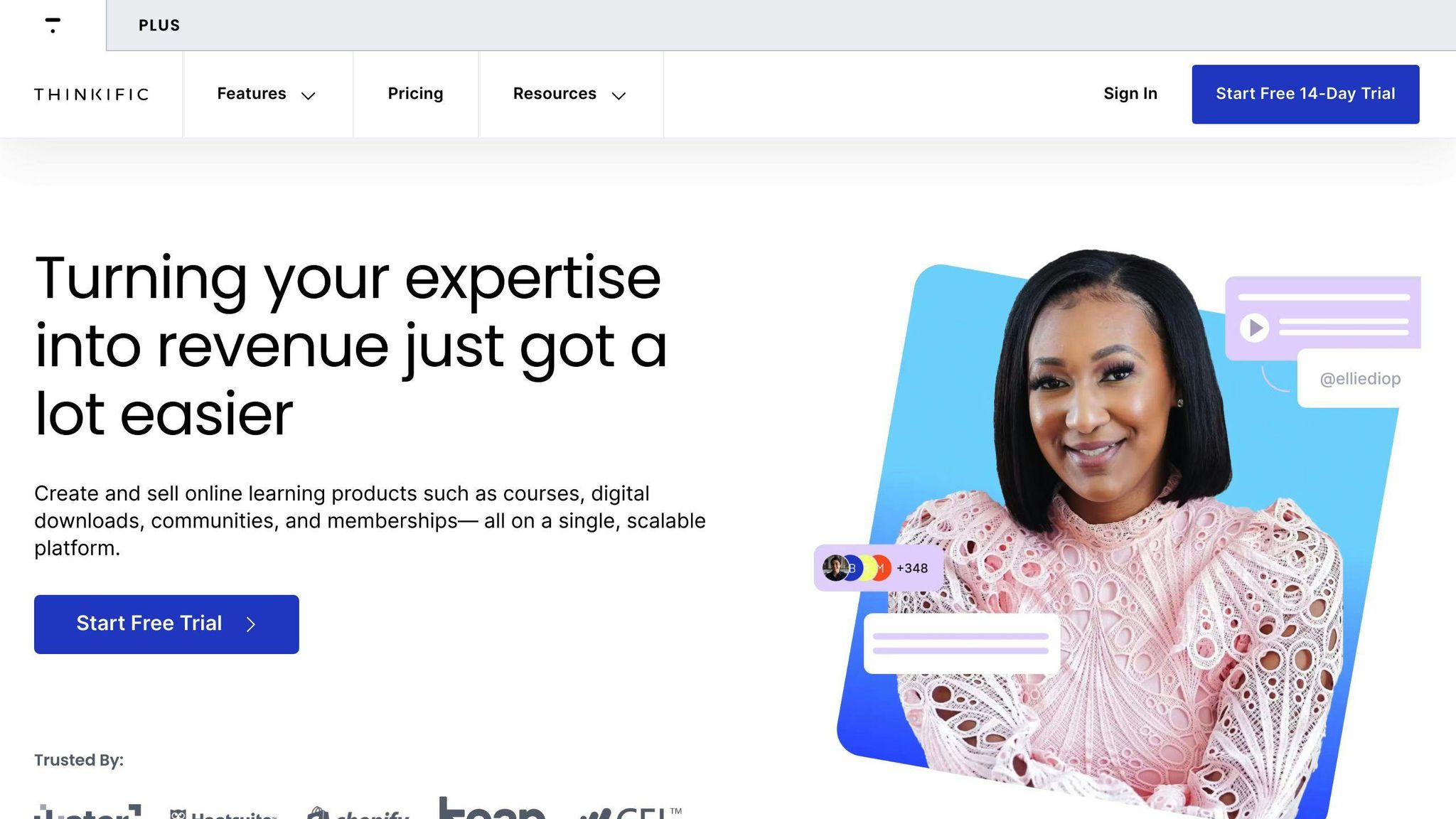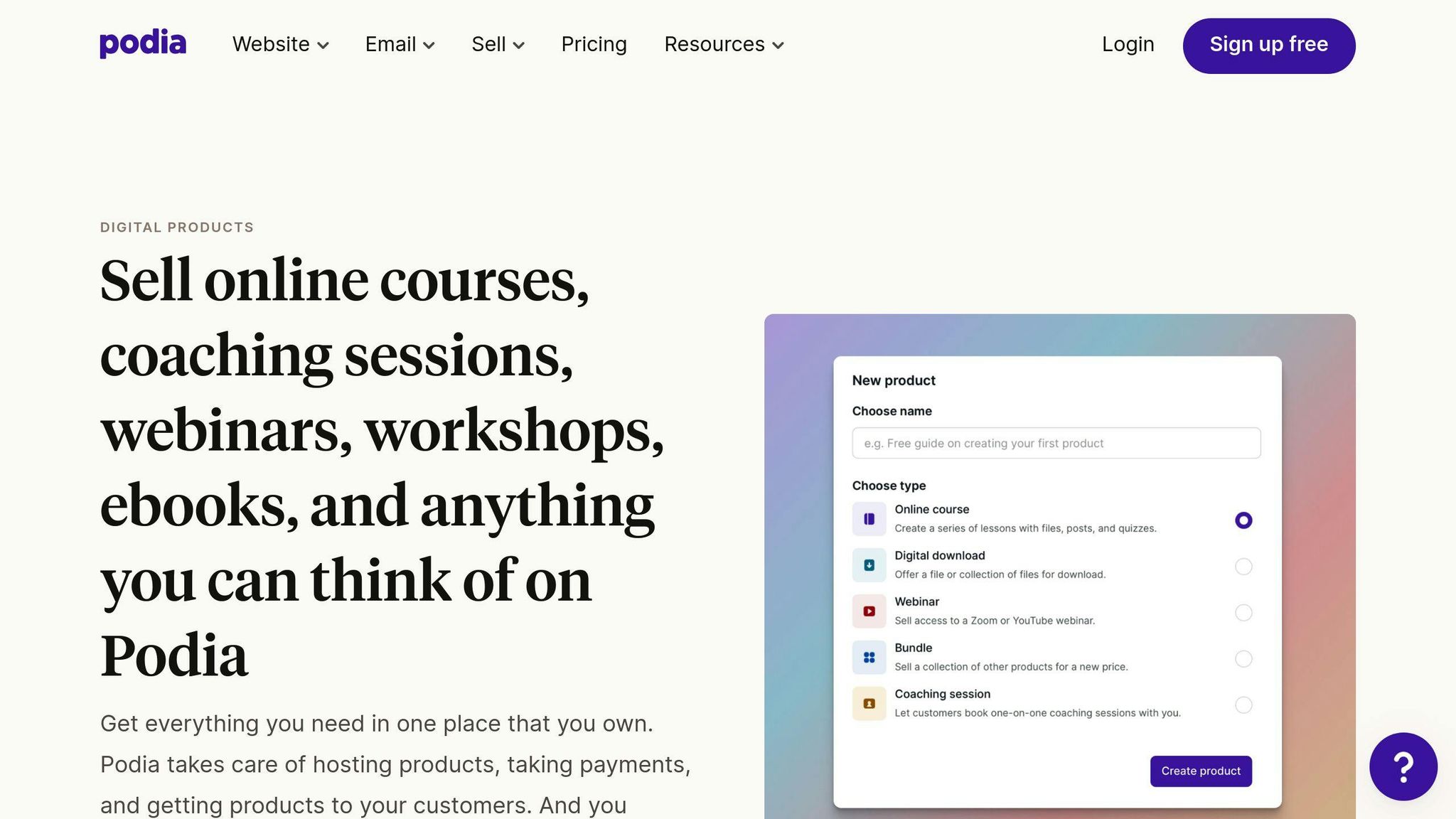The Ultimate Guide to Sell Online Courses for Free: Tips and Tricks
Want to sell online courses without spending money? Here's how:
- Choose a free platform:
-
Create engaging content:
- Plan your course
- Organize lessons
- Record and edit videos
- Upload to your chosen platform
-
Market your course for free:
- Use social media
- Write blog posts
- Build an email list
- Collaborate with other creators
-
Optimize for course marketplaces:
- Use SEO techniques
- Get student reviews
- Join promotions
-
Offer free samples:
- Create preview videos
- Host live Q&As
- Develop a mini-course
-
Build a community:
- Set up a Facebook group
- Run live study sessions
- Encourage student interaction
-
Continuously improve:
- Analyze platform data
- Act on student feedback
- Update content regularly
-
Expand your business:
- Offer additional services
- Create course bundles
- Try affiliate marketing
| Platform | Free Courses | Students | Fee per Sale |
|---|---|---|---|
| Coursera | No limit | No limit | N/A |
| Teachable | 1 | No limit | $1 + 10% |
| Thinkific | No limit | No limit | 0% |
| Podia | 1 | No limit | 8% |
Start selling your expertise online today without upfront costs!
Related video from YouTube
Free Online Course Platforms
Here are some popular platforms where you can sell online courses for free:
Coursera

Coursera works with universities and companies to offer free courses. As an instructor, you can:
- Make hands-on projects
- Create tests
- Reach many students worldwide
But making money is hard on the free plan.
Teachable

Teachable's free plan lets you:
- Host one course
- Have unlimited students
- Build your course easily
- Make basic quizzes
- Manage students
They take $1 + 10% of each sale.
Thinkific

Thinkific's free plan includes:
- No limit on courses or students
- Easy course builder
- Basic quizzes
- Your own web address
But you need to pay for better marketing tools.
Podia

With Podia's free plan, you can:
- Sell one digital product
- Use email marketing
- Take payments easily
They take 8% of each sale.
Platform Comparison
| Feature | Coursera | Teachable | Thinkific | Podia |
|---|---|---|---|---|
| Courses | No limit | 1 | No limit | 1 |
| Students | No limit | No limit | No limit | No limit |
| Fee per sale | N/A | $1 + 10% | 0% | 8% |
| Own web address | No | No | Yes | No |
| Quizzes | Yes | Basic | Basic | No |
| Email marketing | No | No | No | Yes |
| Payments | No | Yes | Yes | Yes |
Look at what each platform offers to find the best fit for your online course.
Picking the Best Platform for Your Course
Choosing the right platform for your online course is key to success. Here's what to look for and how to match features with your course needs.
Key Platform Features
When picking an online course platform, focus on these main features:
- Easy to use: Simple interface for making and managing courses
- Content hosting: Supports different file types and stores them well
- Branding options: Lets you add your own look to your course
- Testing tools: Has quizzes, tests, and homework features
- Student interaction: Offers forums, chat, and Q&A
- Course tracking: Shows how students are doing and how well the course is working
- Connects with other tools: Works with marketing and customer management software
- Payment handling: Offers safe ways to take payments in different currencies
Matching Platform to Course Needs
Different courses need different features. Here's a quick guide:
| Course Type | Features to Look For |
|---|---|
| Tech courses | Code editors, ways to turn in projects |
| Art/Design courses | Places to show work, easy file sharing |
| Business courses | Tools for case studies, group projects |
| Language courses | Audio/video recording, ways to check speaking |
| Fitness courses | Video streaming, progress tracking |
For example:
- For a coding course, pick a platform with built-in code editors and project turn-in options.
- For a photography course, choose one that shows high-quality images and lets students make portfolios.
- For a business course, look for platforms with case study tools and ways for teams to work together.
Making Your Online Course
Here's a step-by-step guide to help you create a good online course:
Planning Course Content
Start with the end in mind:
- Set clear learning goals
- Break down the end result into steps
- Make a course outline based on these steps
Focus on teaching what students need to know, not everything about the topic.
| Part | Purpose |
|---|---|
| Intro | Get students interested |
| Main Lessons | Teach steps to reach the goal |
| Ending | Sum up and give next steps |
Organizing Lessons
Set up your lessons to help students learn better:
- Use different types of content (videos, audio, text, PDFs)
- Add small wins throughout to keep students motivated
- Build on ideas step by step
- Include quizzes and tasks for hands-on learning
Tip: Use lesson planning cards to help you create each lesson.
Recording and Editing
To make good videos:
- Set up a simple filming spot with good light
- Use a decent microphone for clear sound
- Practice talking on camera
- Edit videos to look professional
You don't need expensive gear - a smartphone, computer camera, and basic headphones can work for starting out.
Uploading to Your Platform
When your content is ready:
- Pick where to host your course (like Teachable, Udemy, or Podia)
- Learn how to upload files on that platform
- Put your content in a logical order
- Use bulk upload if you can to save time
Always test your course after uploading to make sure everything works right.
Making Your Course Sell for Free
Here's how to make your free online course stand out and get more students.
Writing a Good Course Description
A clear course description helps students decide if your course is right for them. Here's what to include:
- What students will learn
- Why your course is useful
- Simple words that explain your course well
- How long the course is and how it's set up
- A clear next step for students to take
Here's a good way to set up your description:
- Eye-catching first sentence
- Quick overview of what's in the course
- Main things students will learn
- What makes your course special
- How the course is set up and how long it takes
- What students should do next
Your description should make people want to take your course.
Creating a Good Course Thumbnail
A good thumbnail picture can make more people click on your course. Here are some tips:
- Use clear, high-quality pictures
- Put your course title in easy-to-read letters
- Use colors that match your course topic
- Keep the design simple
- Make sure it looks good big or small
| Part of Thumbnail | What to Do |
|---|---|
| Picture | Clear, matches what the course is about |
| Words | Short, clear title in easy-to-read letters |
| Colors | Use colors that go well together |
| Design | Keep it simple, not too busy |
| Size | Make sure it looks good on different screens |
A good thumbnail can make your course stand out and get more clicks.
Pricing and Enrollment Options
Even for free courses, you can use these ideas to get more students and show your course is valuable:
- Free for a short time: Tell students the course is only free for a little while
- Some free, some paid: Give some parts for free, charge for extra stuff
- Try before you buy: Let students see part of the course before they sign up
- Different prices for different things: Offer different levels of help at different prices
| Option | What It Is | Why It's Good |
|---|---|---|
| Free for a short time | Course is free for a set time | Makes people want to sign up quickly |
| Some free, some paid | Basic stuff free, extra stuff costs money | Lets students try before they pay |
| Try before you buy | Students can see some lessons first | Builds trust |
| Different prices for different things | Different levels of help cost different amounts | Fits what different students need |
These ideas can help you get more students, even if your course is free.
Free Ways to Market Your Course
Here are some no-cost methods to promote your online course and get more students:
Using Social Media
Use social media to reach people who might want to take your course:
| Platform | What to Post | Tips |
|---|---|---|
| Helpful tips, updates about you | Use ads to reach people who visited your page | |
| Pictures, short videos, longer videos | Use hashtags and talk to your followers | |
| Work tips, news about your field | Connect with others in your industry |
Content Marketing
Make good content to show people you know your stuff:
1. Blog Posts: Write helpful articles about your course topic.
2. Guest Posting: Write for other blogs to reach more people.
3. YouTube Videos: Make videos that teach things related to your course.
Growing an Email List
Build a list of emails to tell people about your course:
- Give away a short free course or helpful info to get email addresses.
- Send a series of emails with course info to keep people interested.
- Send regular emails with tips and special offers.
Working with Other Course Creators
Team up with others who make courses:
- Tell your students about each other's courses.
- Do online talks together to show what you know and get new students.
- Offer your courses together at a lower price to give students a good deal.
sbb-itb-be22d9e
Getting Noticed on Course Marketplaces
Here's how to make your online course stand out on big course websites:
Marketplace SEO Tips
Make your course easy to find when people search:
| What to Do | How to Do It | Example |
|---|---|---|
| Use good words in your title | Put main topic words in the title | "Learn Python for Data Work" |
| Write a clear subtitle | Add more info about what you teach | "Use Python to work with data and make predictions" |
| Write a full course description | Tell what's in the course using topic words | "This course teaches you how to use Python for data work. You'll learn about pandas, NumPy, and scikit-learn..." |
| Pick the right tags | Choose tags that match your course | #python #data #machinelearning |
Getting Student Reviews
Good reviews help your course look better:
- Ask students to leave reviews when they finish
- Answer all reviews, good or bad
- Show the best reviews in your course info
- Use feedback to make your course better
Joining Marketplace Promotions
Take part in website sales to get more students:
- Know when sales are happening
- Set your price to fit the sale
- Update your course before big sales
- Make eye-catching pictures or videos for sales
Giving Free Course Samples
Here are three ways to give people a taste of your online course for free:
Making Preview Videos
Preview videos show potential students what your course is like. Here's how to make them:
- Choose what kind of video to make
- Write down what you'll say
- Record and share the video
| Video Type | What It's For | What to Include |
|---|---|---|
| Saying Hello | Introduce yourself | Your background, why you teach this |
| How to Use the Course | Show how to use the course website | Where to find lessons, how to turn in work |
| What's in the Course | Show what students will learn | Tests, projects, what they'll know after |
Hosting Live Q&As
Live Q&As let you talk directly to potential students:
- Have regular times to answer questions about your course
- Show what you know and how you teach
- Let people ask about the course
- Share some helpful tips during the Q&A
These live sessions help build trust and answer questions before people sign up.
Creating a Free Mini-Course
A free mini-course can make people want to take your full course. Here's how to make one:
- Pick a topic related to your main course
- Keep it short
- Make sure it's helpful
- At the end, tell people about your full course
| Mini-Course Part | Details |
|---|---|
| How Long | 3-5 short lessons |
| What's In It | Basic info related to main course |
| How It's Made | Videos, short tests, or things to download |
| What to Do Next | Clear way to sign up for the full course |
Ask people what they think of your mini-course to make it better. This helps you test your ideas and see what people like before you make the full course.
Building a Course Community
Creating a strong community for your online course can help students learn better and stay interested. Here's how to do it:
Setting Up a Facebook Group
A Facebook group for your course is a good way to build a community. Here's how to make one:
- Name the group after your course
- Make it private
- Add a nice cover photo
- Write a clear group description
- Pin a welcome post
| What a Course Facebook Group Does |
|---|
| Lets you talk to students directly |
| Helps you answer questions quickly |
| Keeps students interested |
| Lets students help each other |
| Spreads the word about your course |
Running Live Study Sessions
Live study sessions can help students learn better. Here's how to do them:
- Set regular times for Q&A or topic talks
- Use Zoom or Google Meet
- Plan what to cover, but be ready to change
- Get students to join in with polls or chat
- Record sessions and share them later
Live sessions help students trust you, get answers fast, and see that you know your stuff.
Getting Students to Talk to Each Other
It's important for students to talk to each other. Try these ideas:
- Make a place for casual chats
- Help students form study groups
- Have students check each other's work
- Use live polls during sessions
- Give projects where students share their work
| Ways to Get Students Talking | Why It's Good |
|---|---|
| Discussion boards | Keeps talks going |
| Group projects | Helps students work together |
| Peer reviews | Teaches critical thinking |
| Live chat in sessions | Lets students join in right away |
| Student presentations | Builds confidence |
Improving Your Course
Making your online course better over time is key to its success. Here's how to use data, student comments, and updates to make your course more engaging and helpful.
Reading Platform Data
Look at these important numbers to improve your course:
| Number to Check | What It Means | How to Make It Better |
|---|---|---|
| How many finish | Shows if course is too hard | Make hard parts easier |
| How often students use it | Shows what parts students like | Make more of what they like |
| Test scores | Shows what students understand | Add help for hard topics |
| Time spent on lessons | Shows if content is right level | Add or remove info as needed |
Looking at these numbers helps you see what to fix in your course.
Using Student Comments
What students say can help make your course better:
- Ask for feedback at the end
- Check what students say to each other
- Talk to students one-on-one
- Let students give ideas without names
Look for things many students mention and fix those first. Student comments help you make the course fit what they need.
Updating Your Course
Keeping your course fresh is important. Here's how:
- Check your content every few months
- Add new info from your field
- Use new examples from real life
- Help with parts students find hard
- Add new ways for students to join in
| What to Update | How Often | Why It Helps |
|---|---|---|
| Small fixes | Every month | Keeps course up-to-date |
| Big changes | Once a year | Makes sure course is still good |
| New ways to join in | Every three months | Helps students stay interested |
| Extra help | When needed | Makes hard parts easier |
Growing Your Course Business
Here's how to make your online course business bigger and earn more money:
Selling Extra Services
Offer more than just courses to make extra money:
| Service | What It Is |
|---|---|
| One-on-one coaching | Personal help for students |
| Group workshops | Teaching many people at once |
| Course reviews | Looking at student work |
| Special Q&A times | Answering questions live |
| Done-for-you work | Doing tasks related to your course |
These extras can help students learn more and help you earn more.
Making Course Bundles
Selling courses together can help you sell more:
| Bundle Type | What It Is | Why It's Good |
|---|---|---|
| Same topic | Courses about one subject | Teaches a lot about one thing |
| Different levels | Beginner to advanced courses | Shows clear learning steps |
| Mixed topics | Different but related courses | Teaches more than one thing |
| Time-based | Courses for a set time | Gets students to stay longer |
Bundles can make your courses look worth more and get people to buy more at once.
Trying Affiliate Marketing
Affiliate marketing can help more people find your courses:
1. Start an affiliate program:
- Pick a system that works with your course website
- Decide how much to pay affiliates
- Make things for affiliates to use in marketing
2. Find affiliates:
- Ask people who know your field
- See if your best students want to be affiliates
- Join groups that connect you with possible partners
3. Help your affiliates:
- Show them how to talk about your courses
- Give them good marketing materials
- Keep them updated on sales and changes
4. Check how it's going:
- Look at how well affiliates are doing
- Change pay or plans if needed
- Give top affiliates extra rewards
Wrap-Up
Let's go over the main points for selling online courses for free:
1. Make Good Content:
- Create helpful courses that solve problems
- Keep lessons short (45 minutes or less)
2. Get the Word Out: Use free ways to tell people about your course:
| Method | How to Do It |
|---|---|
| Write blogs and make videos | Share helpful info related to your course |
| Use email | Send updates to people interested in your course |
| Be active on social media | Talk to people and answer questions |
| Work with others | Team up with people who know your topic |
3. Make People Want to Buy:
- Write clear course descriptions
- Use good pictures for your course
- Let people try part of your course for free
4. Show You Know Your Stuff:
- Share helpful tips often
- Speak at online events
- Work with other course makers
5. Pick the Right Tools: Choose a course website that:
- Shows you how many people take your course
- Works with email
- Looks good on phones
6. Keep Making It Better:
- Ask students what they think
- Add new info to keep your course up-to-date
7. Make Money in Different Ways:
- Offer one-on-one help
- Sell courses together in a package
- Let others sell your course for a cut of the money
FAQs
How to sell classes online?
Here's a simple guide to selling classes online:
1. Pick a topic
Choose something you know well and that people want to learn.
2. Make your course
Create good lessons, worksheets, and quizzes.
3. Set up marketing
Plan how to get people interested in your course.
4. Set a price
Look at what others charge and pick a fair price.
5. Make a course page
Write about what students will learn and why it's good.
6. Give something free
Offer a small free lesson to get people interested.
7. Use email
Set up emails to keep in touch with possible students.
8. Tell people about your course
Use social media, write helpful articles, and work with others to spread the word.
| Step | What to Do | Why It's Important |
|---|---|---|
| 1. Pick a topic | Choose what you know | People trust experts |
| 2. Make your course | Create good content | Good lessons keep students happy |
| 3. Set up marketing | Plan how to reach people | More people learn about your course |
| 4. Set a price | Choose a fair amount | Right price helps you sell more |
| 5. Make a course page | Write about your course | Helps people decide to buy |
| 6. Give something free | Offer a small lesson | Shows how good your course is |
| 7. Use email | Keep in touch | Reminds people about your course |
| 8. Tell people | Share on social media and more | Gets more students to join |
Add a New Sales Channel
- • Digital downloads
- • Courses & tutorials
- • Visual & audio assets
- • Game credits or licenses
- • Private memberships

